The story of the crow, the hawk and the mockingbird.
original article by S. Veigel Sep 19, 2024
Warning: This is a true-life tale depicting avian (bird) combat that may be disturbing to some.
Some events were too unexpected and happened too fast to photograph.
I: The Crow
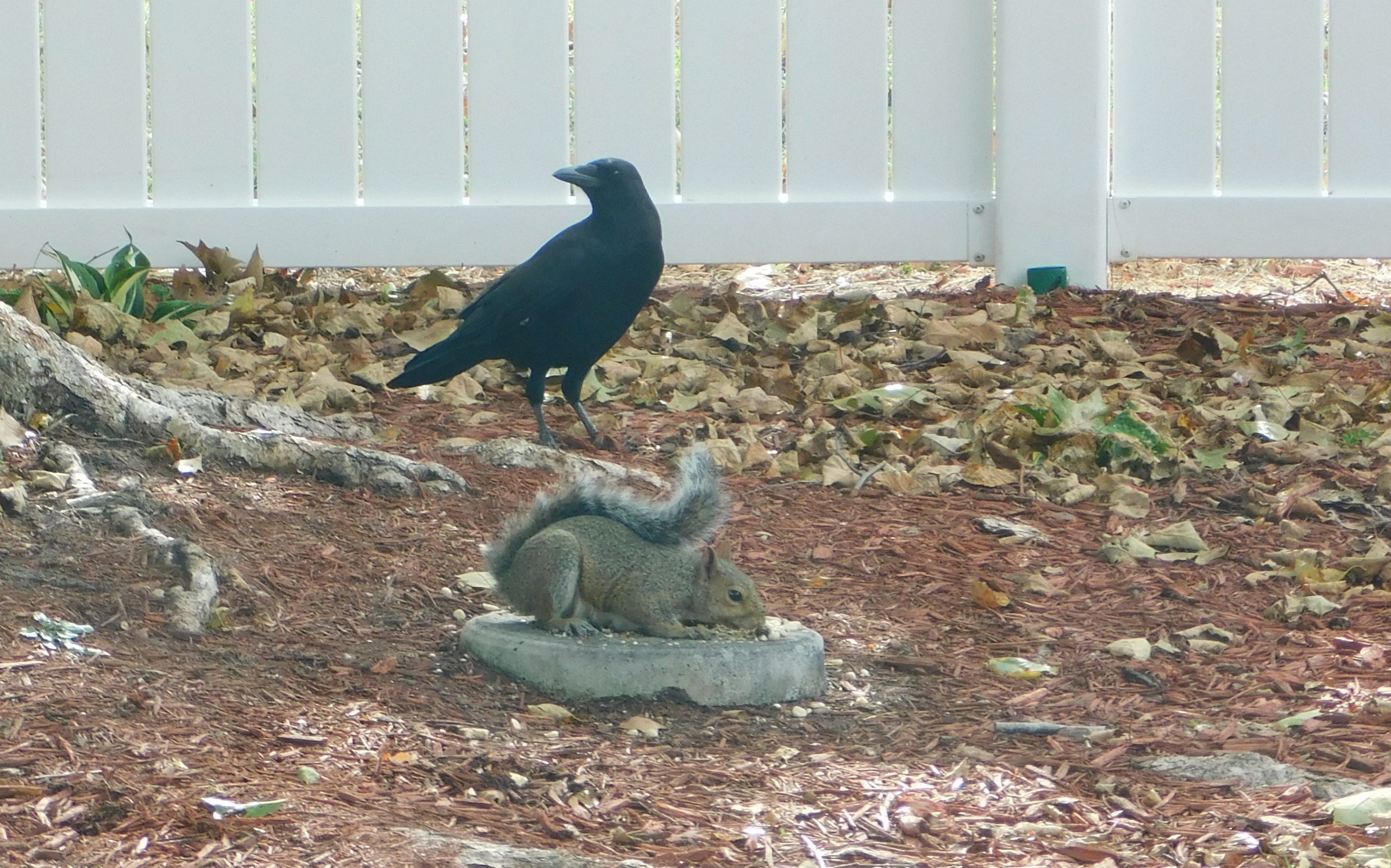 Having been focused on backyard wildlife since 2021, you might be surprised to find that I think the crow is the least appreciated, most magnificent bird I’ve ever seen. Afterall, it is a common black bird many find to be a pest or a nuisance. It has no striking colors or plumage to attract awe inspiring attention, it doesn’t sing pretty songs and the noisy cawing of a group of crows is probably just loud and irritating to some.
Having been focused on backyard wildlife since 2021, you might be surprised to find that I think the crow is the least appreciated, most magnificent bird I’ve ever seen. Afterall, it is a common black bird many find to be a pest or a nuisance. It has no striking colors or plumage to attract awe inspiring attention, it doesn’t sing pretty songs and the noisy cawing of a group of crows is probably just loud and irritating to some.
In the 15th century (1400’s), the poet Geoffrey Chaucer mentioned a “murder of crows” in his poem “The Parliament of Fowls” and it stuck. So today, when we talk about a family of crows (a flock of crows is generally an actual family) we often call that “a murder of crows”.
I once said to people, “Did you hear there was a murder in my backyard? No. Really. There was a murder in my backyard. I’ve got a picture on my phone.” Then I waited, with a little smirk on my face, to see if they caught on to the picture of crows I was showing them.
If you see a gathering of average sized black birds and you’re wondering which one might be a crow, the answer is, “none”. Because, by comparison, the crow is the giant. Compared to the hawk, however, the average crow is slightly smaller than the average hawk. But standing between 17 and 19 inches (measured from beak to tail), with a wingspan between 33 to 39 inches, the crow is a formidable contender.
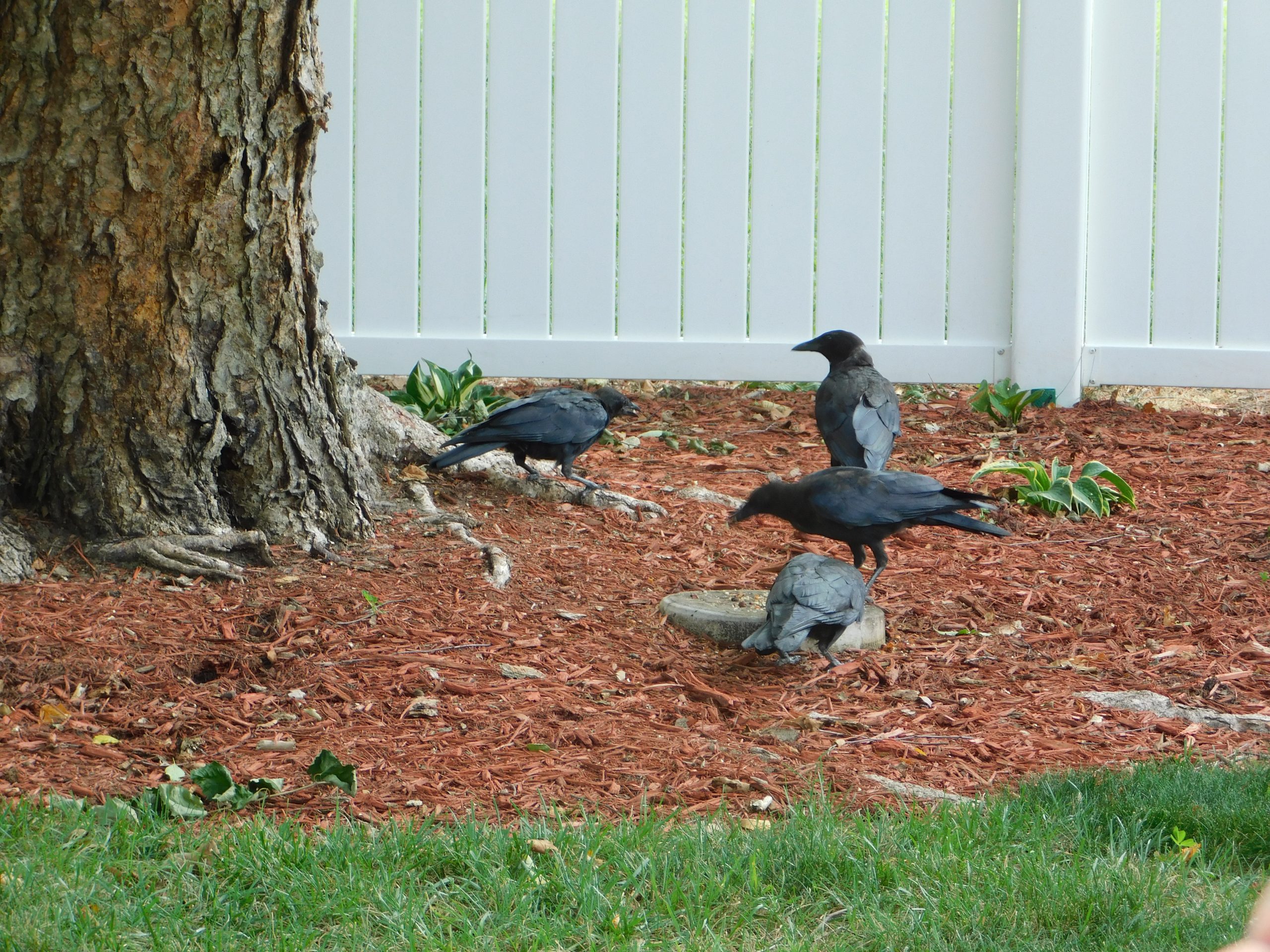 You may not know this, but crows are very intelligent. They have been shown to work puzzles as a team. For example, one crow would stand on a lever to raise a box so the other family members could eat the food stored underneath. They also don’t always just “caw”. Cawing is a way to call out to the family who are spread out looking for food. But when they’re together they often speak in more complex ways, with clicks, tics and various guttural sounds.
You may not know this, but crows are very intelligent. They have been shown to work puzzles as a team. For example, one crow would stand on a lever to raise a box so the other family members could eat the food stored underneath. They also don’t always just “caw”. Cawing is a way to call out to the family who are spread out looking for food. But when they’re together they often speak in more complex ways, with clicks, tics and various guttural sounds.
In the early 2000’s there was a crow atop an electrical pole as I left work going out to my car. It would sound, “Ah haw. Ah haw. Ah haw.” I often mused that it was laughing at me for getting stuck working late again.
As omnivores crows can sometimes get into trouble. Like the Bluejay, a hungry crow might see another bird’s nestling as something small enough to eat. But they’re not really built for it. I once watched a crow on a tree branch holding something by its foot while trying to eat it. It may have been a nestling or even a piece of roadkill. Try as it may, it was not successful. The object fell from its grasp onto the ground and the crow then flew off to find something else to try.
The crow may be a threat to some nestlings, but the crow is not a threat to any adult bird or mammal. I’ve seen them longingly ponder the “Nut N Fruit” I provide on 3 round stones. Looking for an opportunity to eat or to get a drink of water, they were often deterred by the activity of birds of varying sizes and the squirrels. Seeing me on the patio you might say they were even cowardly in their approach. They’d wait until everyone was spread out or gone and only then drop down to enjoy some water and some food.
Over the years I learned some things about crows. Found them more interesting. But I never appreciated them. Until the hawk started showing up.
II: The Hawk
Hawks are among the predator birds generally referred to as “raptors”. The hawk is built for one thing. Killing and eating anything small enough to grab. With sharp talons over an inch in length, it punctures its prey and keeps it in its suffocating grasp until it can fly off to a safe location and rip the flesh apart with its curved beak.
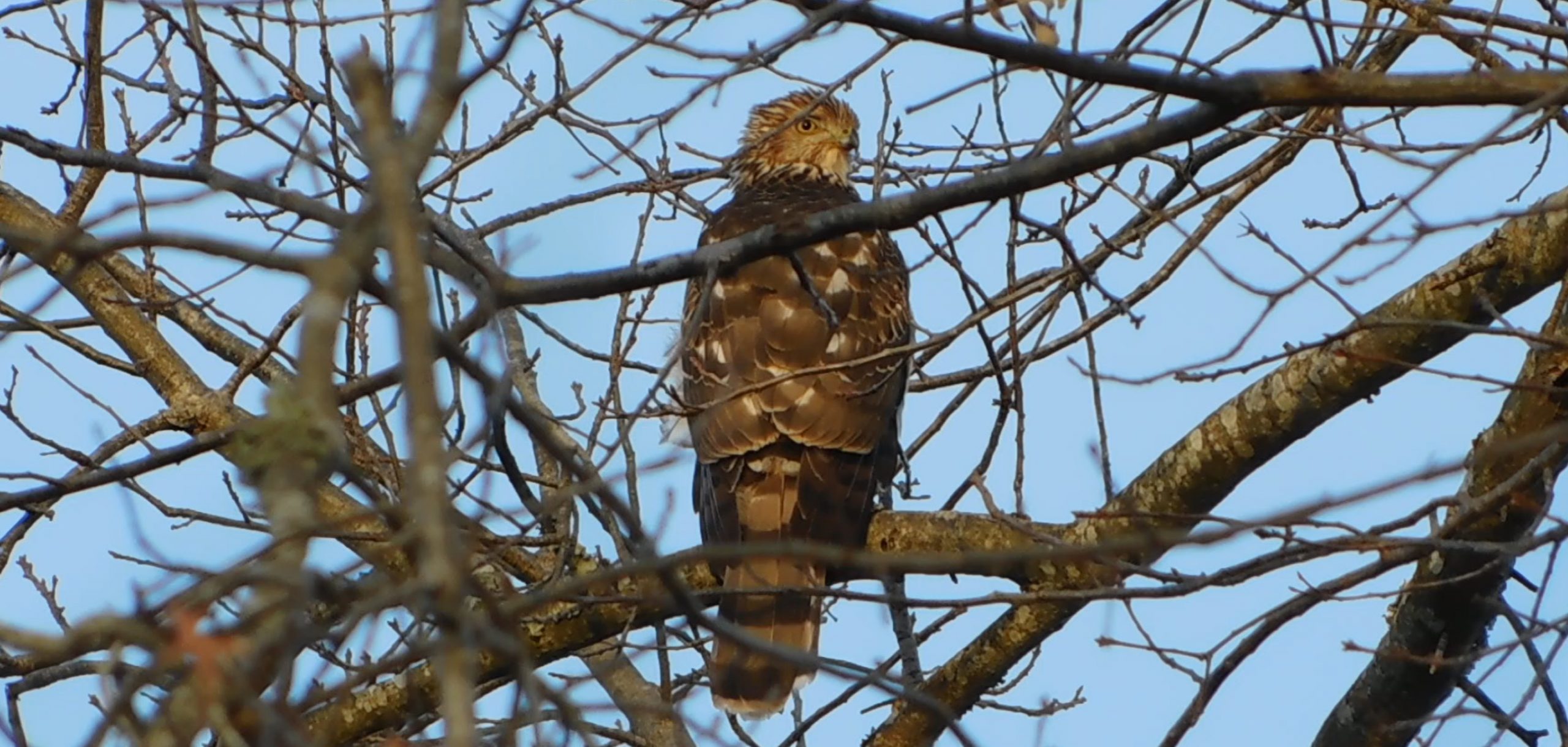 The Cooper’s Hawk, for example, stands between 14 to 20 inches with a wingspan of 24 to 39 inches. Compared to the crow, standing at 17 to 19 inches with a wingspan of 33 to 39 inches, it’s not hard to see that these are both birds of equal stature. With the hawk having the advantage of a sharp hooked beak and long sharp talons.
The Cooper’s Hawk, for example, stands between 14 to 20 inches with a wingspan of 24 to 39 inches. Compared to the crow, standing at 17 to 19 inches with a wingspan of 33 to 39 inches, it’s not hard to see that these are both birds of equal stature. With the hawk having the advantage of a sharp hooked beak and long sharp talons.
Unlike depictions in movies, cartoons and anime, raptors don’t screech as they dive for an attack. Their attack is a swift calculated stealthy glide path with high impact and take off.
One day I saw a brown blur in my peripheral vision. As I looked up, all I saw was a puff of dove feathers where the hawk grabbed a mourning dove off the fence.
Early on, a hawk dropped into my yard intending to kill a one-legged bird who had been coming into my yard to feed off the round stones and to get some water. I stood up and suddenly distracted the hawk, who then flew up onto the north fence. As I walked with purpose over to the hawk, it stayed in a moment of uncertainty. I was close enough now to reach out and grab it.
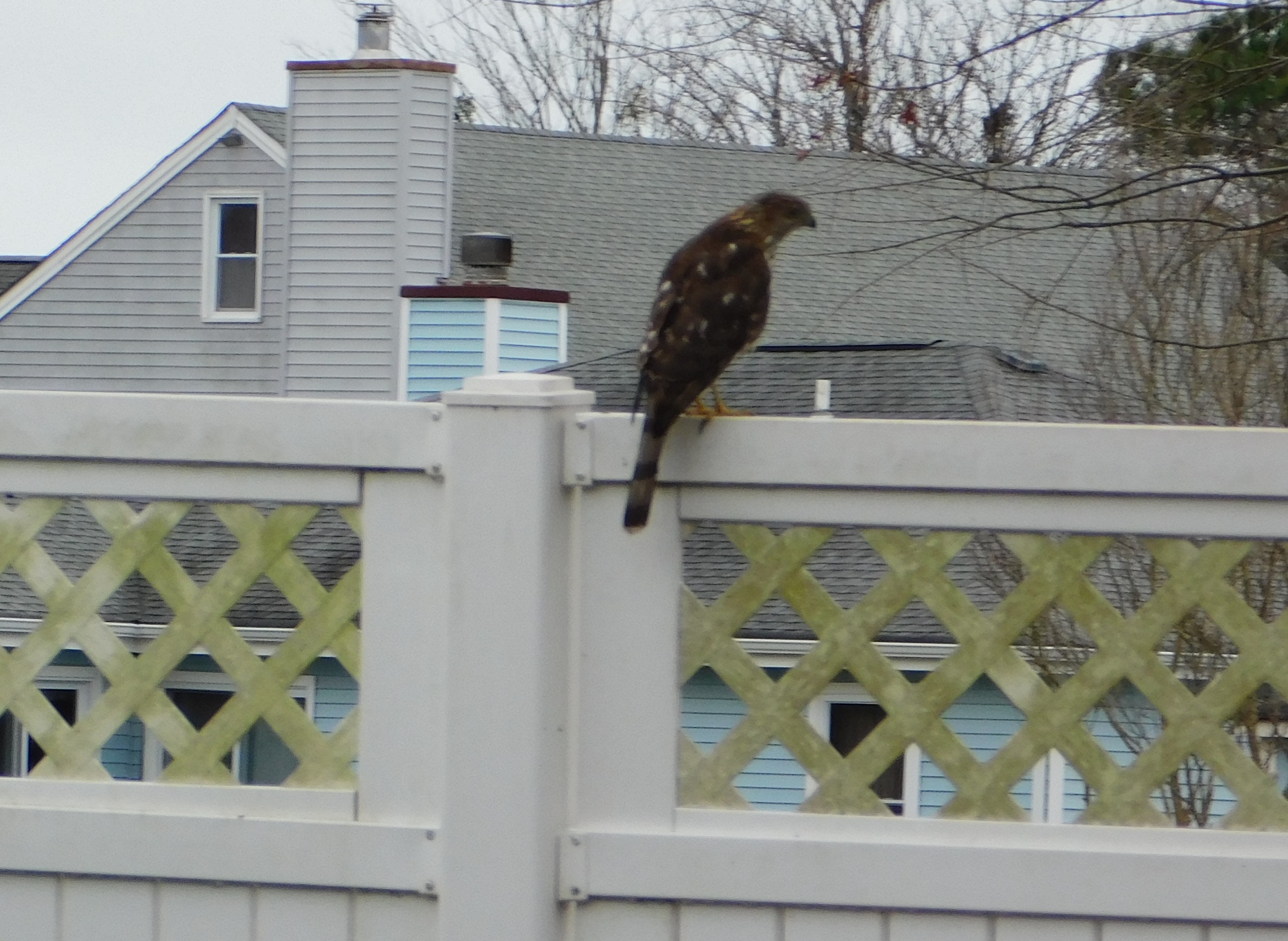 There is of course no way the hawk could understand anything I said but I was making eye contact and wanted to make an announcement. “I respect you”, I said, “I’m not going to hurt you. But I am not setting up a buffet here”. The hawk turned and flew off into a neighbor’s yard.
There is of course no way the hawk could understand anything I said but I was making eye contact and wanted to make an announcement. “I respect you”, I said, “I’m not going to hurt you. But I am not setting up a buffet here”. The hawk turned and flew off into a neighbor’s yard.
From that day forward the hawk knew I was probably there somewhere. That I could come out of nowhere and confront it. And that I did. And there would be many confrontations. I could always tell if a bird flying into the trees was just a little too big and noisy. All the birds flew off in a panic and the squirrels ran up the trees screaming out a warning as loud as they could.
The advantage to my feeding area is simple. Lots of obstacles. A roof now over the patio, two river birch trees, a fence, an arbor and plenty of bushes. All complicating a hawk’s high speed stealthy glide toward its prey. Forcing the hawk to land at some point. And in so doing leaving itself vulnerable.
III: Combat
Crow V Hawk
In the early spring of 2024, I happened to look out through my glass storm door and witnessed an amazing sight. I was so taken by the scene in front of me that I didn’t even think of grabbing a camera.
On the eastern fence, between the river birch trees, was a crow facing off with a hawk. They were so close their confrontation could not possibly be misunderstood. Within 2 feet of each other, neither one was going to move. It was an intense stare down.
Seriously hoping to get a good picture, I slowly and quietly slipped out onto the patio. The hawk took advantage of that momentary distraction and flew off onto a nearby tree branch in the city park. “That’s it”, I thought. But the crow was not finished.
The crow quickly flew to the tree branch where the hawk was standing and started chest bumping it off the branch. The next amazing sight was the crow and the hawk frantically flapping their wings in mid-flight, each desperate to stay in the air.
Though you might think the hawk possessed the weapons to defeat the crow, it was the crow who had the advantage of strength, momentum and determination. It was the crow, in the hawk’s face, pushing it further and further away from the tree that was winning the day. Until the hawk finally broke free and flew to another tree.
The two combatants now sat in separate trees with the crow standing its ground and the hawk flying away. Yes, there was combat, but once the crow made its point, it was over.
As time went on I concluded that, when there’s a direct confrontation between the crow and the hawk, “always bet on black”.
IV: The Mockingbird
An obsessively aggressive strategy
The Mockingbird is described as a medium sized songbird about 9 to 10 inches in length (from beak to tail) with a wingspan of 12 inches across. I always spot mockingbirds by their long tail that folds up very straight (like a board). A tail measuring about 4 to 5 inches.
Now I will support any mother of any species defending her babies, but I tend not to be fond of mockingbirds during nesting season. Because the mockingbird tends to be aggressively obsessive during this period. And though I understand that is their strategy for survival I recall mockingbirds dive bombing my wife in the garden and my dogs who just wanted to be in the yard for a while. They didn’t have to be threatening a mockingbird’s nest, they just had to be within a hundred feet.
When all the birds and animals are posturing for position to get some of the food I provide, or are otherwise waiting for the opportunity, the mockingbird can be a bit of a terrorist. It lands on the fence screeching and then dives in startling everyone, making them jump for cover or fly off while the mockingbird takes what it wants.
But hey, that’s nature. Nothing I can do about it. And yet, while nesting season was in session, I really found myself getting unduly irritated by this particular bird.
V: Combat
Mockingbird V Crow
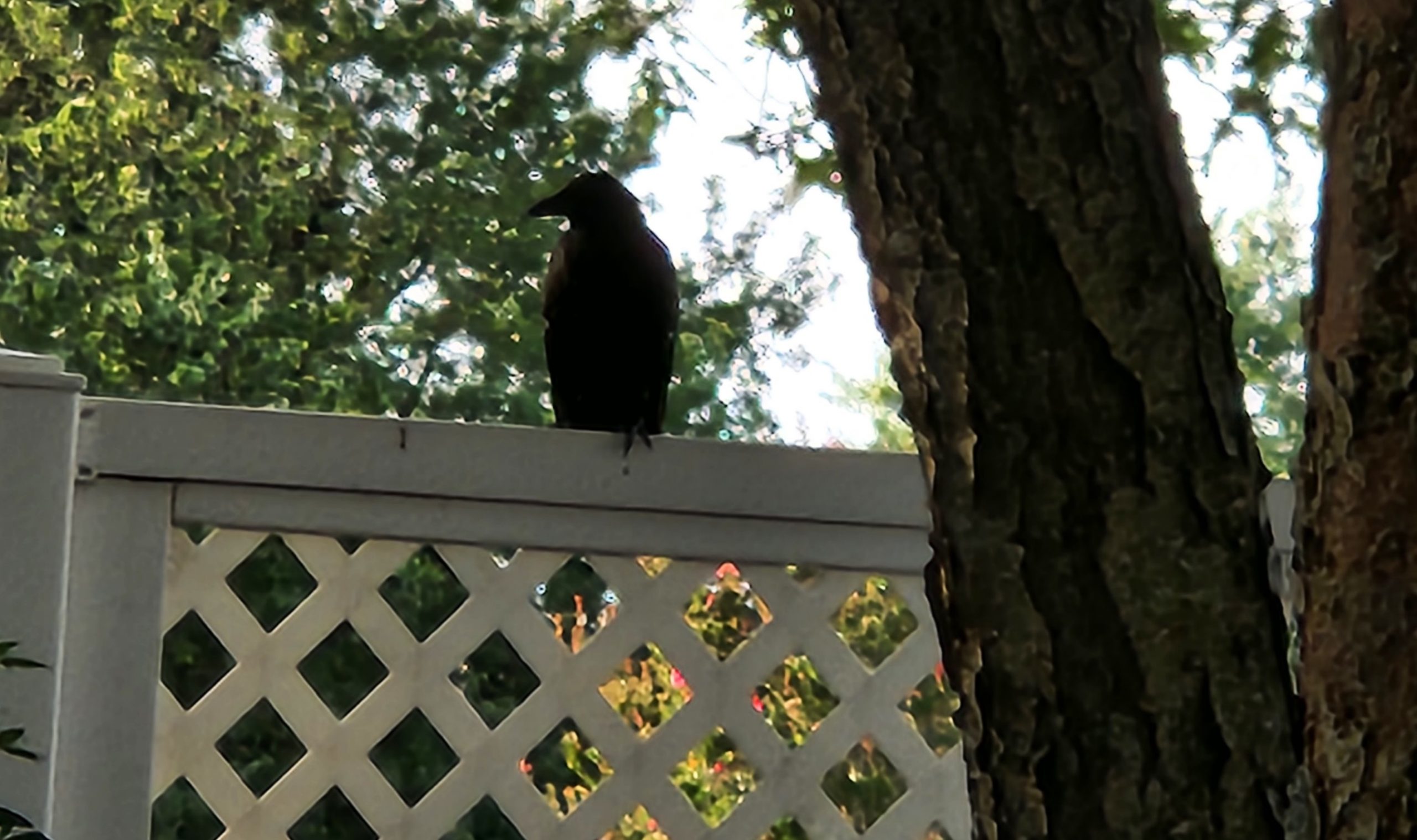 So, there was this one crow above the others in that family that would land on the fence and contemplate the food and water provided there. While there, it never disturbed all the other animals and birds. So naturally I grew to have a special affinity for that crow. But in the mockingbird nesting season that was not possible. As a matter of fact, when mockingbirds were nesting, I rarely heard or saw any crows, save that one. And in the absence of the crows the hawk had free rein.
So, there was this one crow above the others in that family that would land on the fence and contemplate the food and water provided there. While there, it never disturbed all the other animals and birds. So naturally I grew to have a special affinity for that crow. But in the mockingbird nesting season that was not possible. As a matter of fact, when mockingbirds were nesting, I rarely heard or saw any crows, save that one. And in the absence of the crows the hawk had free rein.
One day I looked up and saw that one crow flying through the area with several mockingbirds giving chase. Trying to be cute about that I said, “Did you get yourself into trouble today?” But that tolerant understanding soon became anger for the mockingbird.
Most of the time, when creatures of all sorts chase another away from a nest, there is a point to where they’ve made their point and go back to caring for their nest. Early on I mentioned the crow who bested the hawk and, having made its point, ended the conflict. But day after day I watched as more and more mockingbirds joined in the chase after that one crow.
From my seat on my patio, though there are some trees in my view, I can see a quarter to a full mile to the north, east and south. Day after day I watched that crow flying in every direction trying to shake the mockingbirds off its tail to no avail. Hour after hour, day after day. If that crow even flew through the area the mockingbirds would go after it. So, forgive me if I no longer had any tolerance for this obsession that actually kept the mockingbirds leaving their own nests unguarded.
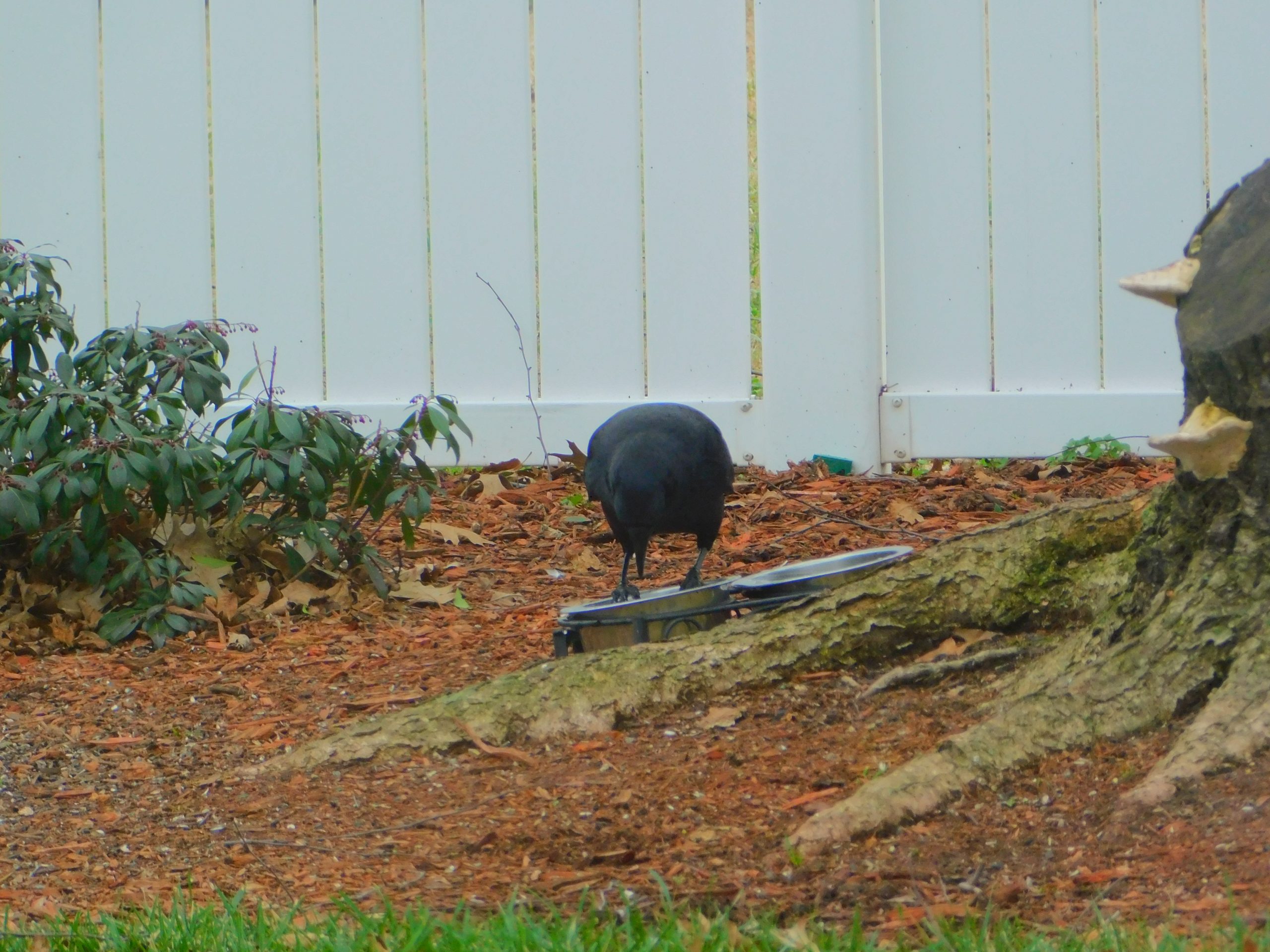 One hot summer day in 2024 it was 90 degrees Fahrenheit. The one crow finally landed in my yard without mockingbirds in tow. Its mouth was gaping wide from exhaustion and thirst. It was moving toward the water bowls it knew I kept there by the river birch tree. But by the time it got within a foot and a half of water, the mockingbirds dove in forcing it to again take to flight.
One hot summer day in 2024 it was 90 degrees Fahrenheit. The one crow finally landed in my yard without mockingbirds in tow. Its mouth was gaping wide from exhaustion and thirst. It was moving toward the water bowls it knew I kept there by the river birch tree. But by the time it got within a foot and a half of water, the mockingbirds dove in forcing it to again take to flight.
Another day my friend Patrick and I were sitting on the patio. As we were talking, my eyes were constantly focusing on the mockingbirds chasing that crow again. In that conversation between Patrick and I my mood turned to a feeling of anger about the scene playing out in the skies above.
Suddenly the crow landed on the air conditioning unit next to the patio hoping to rest there. But in seconds the mockingbirds swarmed in. The crow then flew across the patio between our heads and the patio roof attempting to escape onto the southern fence. But again, there were a considerable number of mockingbirds attacking the crow. Then, in a last-ditch effort, the crow flew behind the southern-most river birch tree, between the tree and the fence.
We could not see what was going on exactly, but the mockingbirds were visible on the ground and on the fence. All you could hear were the mockingbirds screeching at the crow, until, suddenly, the crow flew up onto the fence and confronted the mockingbirds holding one of them in its mouth by the neck. Though still on the fence and the ground by the fence, the mockingbirds went silent. The attack stopped and the crow just stood there glancing back and forth at the mockingbirds gathered before it with that dead bird dangling from its mouth. Daring them to keep it up.
Once satisfied the mockingbirds were going to stop their attack, the crow turned and flew off with the kill. Patrick and I looked at the scene wide eyed. I looked at Patrick and said, “That crow was pissed!” Patrick responded, “Ya he was.” Then I emphasized with some satisfaction in the end of the crow’s torment, “That crow was really pissed!”
VI: Witness to Mythology
It was now August of 2024. The Mockingbirds had long since stopped tormenting the crow and the crow family returned to the area. There was still the threat of a hawk, but somehow hearing the cawing of crows nearby made the day much more pleasant for everyone.
On the day I’m describing now though, the hawk figured out an attack plan. There was a blackbird on the fence. Suddenly the hawk swooped in at an angel, diving between the tree branches and the south fence, to snatch the bird. The hawk’s talons hit the blackbird with such force as to cause it to be terminally injured. But the attack plan had a serious flaw.
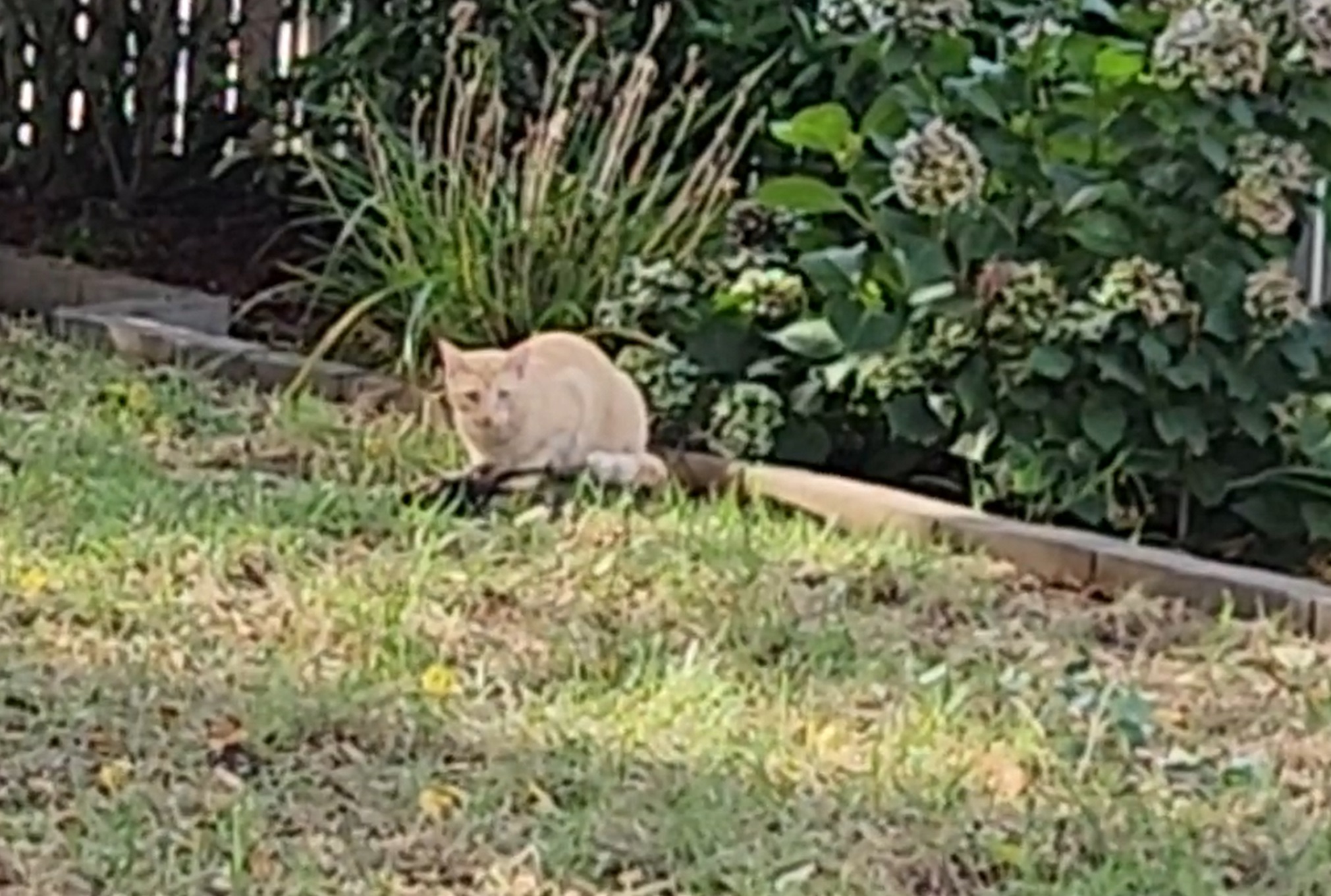 For the hawk to make the attack, its steep angle forced the hawk to land in the yard with its prey in its clutches. In the next second the hawk looked up and saw three large crows standing side by side on the east fence within 15 feet of the scene. The crows didn’t even flinch. But the hawk stared up at them in total surprise for several seconds.
For the hawk to make the attack, its steep angle forced the hawk to land in the yard with its prey in its clutches. In the next second the hawk looked up and saw three large crows standing side by side on the east fence within 15 feet of the scene. The crows didn’t even flinch. But the hawk stared up at them in total surprise for several seconds.
Obviously not liking its situation, the hawk figured out that, to get enough lift and fly off to safety, it would have to let go of its prey. It then took off flying up at an angle down range and over the same east fence that the crows were standing on.
There was a pause for a couple of seconds. Then one single crow turned and flew off in the direction of the hawk. The other two remained motionless. Like black robed judges bearing witness to the scene. They remained there for some time and then flew off to tend to their own life.
A moment later, a yellow cat I hadn’t seen in several months came in under the east fencing. Without hesitation it strolled over to the blackbird. It looked down, nose close, then gently pawed the body. Seeing me sitting on the patio it sat, rolled back belly up with a curved paw and then casually strolled by and out under the west gate.
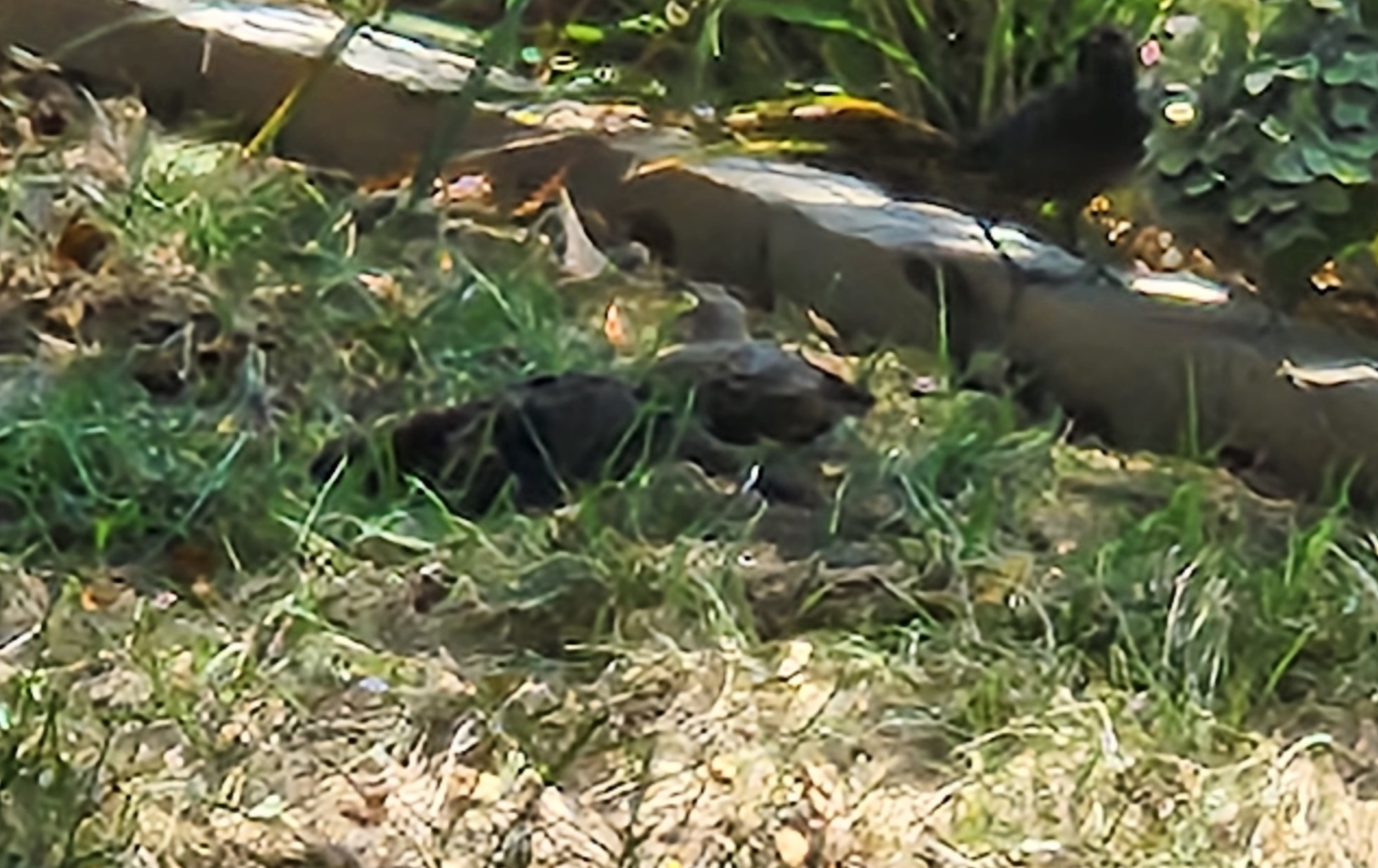 As surreal as this all was, I knew I was now going to be forced to dispose of the blackbird’s body. But I have a quirk about letting the dead have some dignity first. So I let it lay there undisturbed while having this strange feeling that I was getting some answers to some abstract questions I had. After pondering it all, I went into the house.
As surreal as this all was, I knew I was now going to be forced to dispose of the blackbird’s body. But I have a quirk about letting the dead have some dignity first. So I let it lay there undisturbed while having this strange feeling that I was getting some answers to some abstract questions I had. After pondering it all, I went into the house.
Compelled to look out the window at the blackbird I’d have to take care of, I was even more captivated by what I saw. There was a mourning dove sitting with the body. Not just close, up against the body. It must’ve sat there for more than an hour. As if tending to it while its soul moved on. The next day, the body was gone.
We could argue what happened to the body of the blackbird. Maybe the hawk came back to claim its prey. Maybe some other predator didn’t mind taking a dead animal. But if I were to write a fable, or myth, or an animal story, this would all certainly be part of the story board. They say, “all myths are based on some reality”. More than those myths, however, all these events are absolutely based in reality.
If I were to write an animal story, the crow would be the hero. A hero with faults that not all particularly liked. A hero sometimes aggressively and unduly tormented. But a hero with intelligence, goodwill toward the other animals and a brave heart. A hero willing to stand up to a foe far more deadly and win with determination and strength.
And that, my friends, is why I think the crow is the most magnificent bird I’ve ever seen.